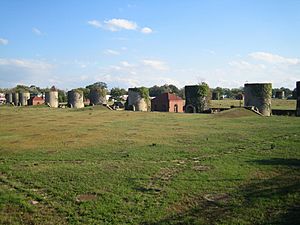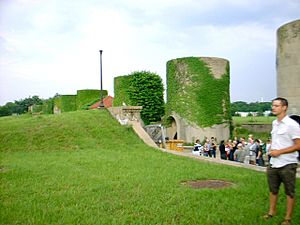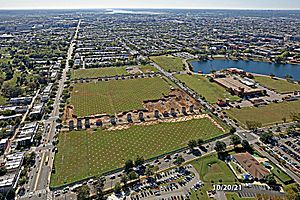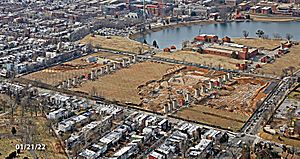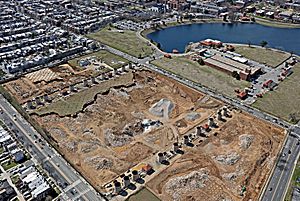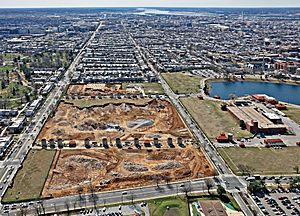McMillan Sand Filtration Site facts for kids
The McMillan Sand Filtration Site is a large, historic area in northwest Washington, D.C.. It used to be a special plant that cleaned water for the city. This 25-acre site is part of the old McMillan Reservoir Park. It is surrounded by Michigan Avenue, North Capitol Street, Channing Street, and McMillan Drive.
Above ground, the site had cool buildings like regulator houses and tall sand bins. There were also sand washers and entrances to the underground filter cells. People used to walk around here like a park before it was fenced off during World War II.
Underneath the ground, there are 20 huge, cave-like rooms, each about an acre big. Inside these rooms, sand was used to clean water from the Potomac River. This water came through the Washington Aqueduct. This old way of cleaning water, called a slow sand filter, became outdated. In 1985, a new, faster water cleaning plant was built nearby. The Army Corps of Engineers runs the new water treatment system.
The public has not been able to visit the site easily since World War II. The Army put up fences to protect the city's water supply from harm. For a while, special tours were given twice a year for people who wanted to see the unique buildings. But the site never fully opened to the public again like it was before the war.
In 1991, a group called the D.C. Historic Preservation Review Board named McMillan Park a Historic Landmark. They also suggested it be added to the National Register of Historic Places. The site was even listed as one of the "Most Endangered Properties" in 2000 and again in 2005.
Contents
History of the McMillan Site
The McMillan Reservoir Sand Filtration Plant was finished in 1905. This was a very important moment for public health in Washington. Its new way of cleaning water used sand instead of chemicals. This helped stop outbreaks of typhoid and reduced many other diseases in the city.
The plant was a big part of the City Beautiful Movement and the McMillan Plan. These plans aimed to make Washington a more modern city. The complex was an amazing engineering project. It cleaned water for the city until 1986.
People living near the park loved to visit it. They enjoyed the park no matter their race, which was special in a city that was often separated. Couples walked on the paths under trimmed trees. Families sometimes slept there on hot summer nights to catch cool breezes. During World War I, Girl Scouts even camped and grew vegetables on the site. Boys played ball games where there were fewer manhole covers. They sometimes laughed when they fell through an open manhole cover into the sand below!
While the Corps of Engineers owned the site, no businesses were built there. In 1983, the National Capital Planning Commission said that McMillan Park should stay an "Open Space." This meant it should be kept as a park and natural area.
However, the site's future became unclear in 1986. The Corps of Engineers said they no longer needed the property. They asked the General Services Administration to sell it. This agency thought the land would be better used for businesses and homes, not just open space. They wanted to sell it for development, even though the McMillan Park Committee disagreed.
The D.C. government bought the site from the federal government in 1987 for $9.3 million. They wanted to use it for new buildings. Since then, the property has remained unused and closed to the public.
What's Happening Now at McMillan
Plans for Development
The D.C. government started thinking about building homes and shops on the McMillan Sand Filtration Site again in 2007. A city development agency chose the site as part of a land deal. This deal involved land near the Anacostia River and building the Nationals Park baseball stadium.
In 2007, a development team called Vision McMillan Partners (VMP) was chosen. Their plan includes a mix of uses, such as homes, shops, and offices. The site would also have new park areas. This includes about 6.25 acres at the south end and a 1-acre healing garden at the north end. There would also be an acre of green space over a preserved underground cell.
Some neighborhood groups have not agreed with the VMP plan. However, the team has been meeting with nearby communities since before 2007. They have included ideas from the neighborhoods in their project changes. The Historic Preservation Review Board approved the plan in May 2016. They vote on the buildings, but not the overall plan for the site.
In 2013, DC Water suggested using McMillan to help with flooding in the Bloomingdale neighborhood. This area often had problems with too much water. The plan suggests using two of the underground cells to hold water. It also involves tearing down some cells to get to a tunnel they plan to build. This tunnel would help manage the water system.
In 2016, courts sided with community groups. They rejected the DC Zoning Commission's approval of a $720 million project. This project aimed to turn the site into shops, offices, and homes.
City Council and Court Decisions
In the summer of 2021, the City Council passed a law. This law allowed demolition work to start at the McMillan site. In October 2021, the D.C. Court of Appeals decided that the proposed development project could go ahead. This was based on the new law. Demolition of the site began in October 2021.
Images for kids


